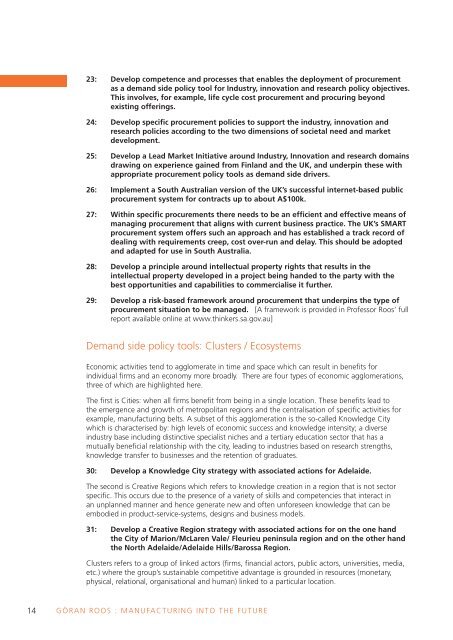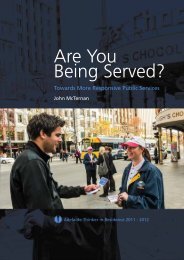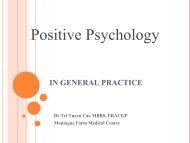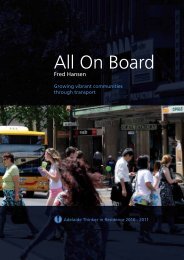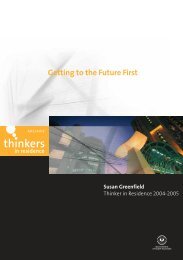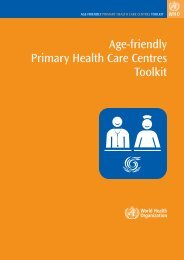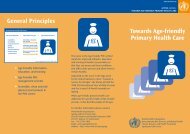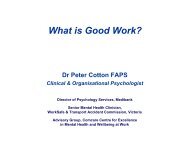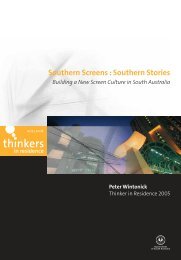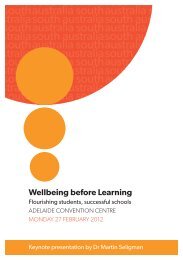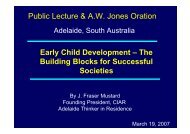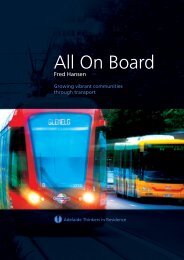Manufacturing into the future - Adelaide Thinkers in Residence - SA ...
Manufacturing into the future - Adelaide Thinkers in Residence - SA ...
Manufacturing into the future - Adelaide Thinkers in Residence - SA ...
- No tags were found...
You also want an ePaper? Increase the reach of your titles
YUMPU automatically turns print PDFs into web optimized ePapers that Google loves.
23: Develop competence and processes that enables <strong>the</strong> deployment of procurementas a demand side policy tool for Industry, <strong>in</strong>novation and research policy objectives.This <strong>in</strong>volves, for example, life cycle cost procurement and procur<strong>in</strong>g beyondexist<strong>in</strong>g offer<strong>in</strong>gs.24: Develop specific procurement policies to support <strong>the</strong> <strong>in</strong>dustry, <strong>in</strong>novation andresearch policies accord<strong>in</strong>g to <strong>the</strong> two dimensions of societal need and marketdevelopment.25: Develop a Lead Market Initiative around Industry, Innovation and research doma<strong>in</strong>sdraw<strong>in</strong>g on experience ga<strong>in</strong>ed from F<strong>in</strong>land and <strong>the</strong> UK, and underp<strong>in</strong> <strong>the</strong>se withappropriate procurement policy tools as demand side drivers.26: Implement a South Australian version of <strong>the</strong> UK’s successful <strong>in</strong>ternet-based publicprocurement system for contracts up to about A$100k.27: With<strong>in</strong> specific procurements <strong>the</strong>re needs to be an efficient and effective means ofmanag<strong>in</strong>g procurement that aligns with current bus<strong>in</strong>ess practice. The UK’s SMARTprocurement system offers such an approach and has established a track record ofdeal<strong>in</strong>g with requirements creep, cost over-run and delay. This should be adoptedand adapted for use <strong>in</strong> South Australia.28: Develop a pr<strong>in</strong>ciple around <strong>in</strong>tellectual property rights that results <strong>in</strong> <strong>the</strong><strong>in</strong>tellectual property developed <strong>in</strong> a project be<strong>in</strong>g handed to <strong>the</strong> party with <strong>the</strong>best opportunities and capabilities to commercialise it fur<strong>the</strong>r.29: Develop a risk-based framework around procurement that underp<strong>in</strong>s <strong>the</strong> type ofprocurement situation to be managed. [A framework is provided <strong>in</strong> Professor Roos’ fullreport available onl<strong>in</strong>e at www.th<strong>in</strong>kers.sa.gov.au]Demand side policy tools: Clusters / EcosystemsEconomic activities tend to agglomerate <strong>in</strong> time and space which can result <strong>in</strong> benefits for<strong>in</strong>dividual firms and an economy more broadly. There are four types of economic agglomerations,three of which are highlighted here.The first is Cities: when all firms benefit from be<strong>in</strong>g <strong>in</strong> a s<strong>in</strong>gle location. These benefits lead to<strong>the</strong> emergence and growth of metropolitan regions and <strong>the</strong> centralisation of specific activities forexample, manufactur<strong>in</strong>g belts. A subset of this agglomeration is <strong>the</strong> so-called Knowledge Citywhich is characterised by: high levels of economic success and knowledge <strong>in</strong>tensity; a diverse<strong>in</strong>dustry base <strong>in</strong>clud<strong>in</strong>g dist<strong>in</strong>ctive specialist niches and a tertiary education sector that has amutually beneficial relationship with <strong>the</strong> city, lead<strong>in</strong>g to <strong>in</strong>dustries based on research strengths,knowledge transfer to bus<strong>in</strong>esses and <strong>the</strong> retention of graduates.30: Develop a Knowledge City strategy with associated actions for <strong>Adelaide</strong>.The second is Creative Regions which refers to knowledge creation <strong>in</strong> a region that is not sectorspecific. This occurs due to <strong>the</strong> presence of a variety of skills and competencies that <strong>in</strong>teract <strong>in</strong>an unplanned manner and hence generate new and often unforeseen knowledge that can beembodied <strong>in</strong> product-service-systems, designs and bus<strong>in</strong>ess models.31: Develop a Creative Region strategy with associated actions for on <strong>the</strong> one hand<strong>the</strong> City of Marion/McLaren Vale/ Fleurieu pen<strong>in</strong>sula region and on <strong>the</strong> o<strong>the</strong>r hand<strong>the</strong> North <strong>Adelaide</strong>/<strong>Adelaide</strong> Hills/Barossa Region.Clusters refers to a group of l<strong>in</strong>ked actors (firms, f<strong>in</strong>ancial actors, public actors, universities, media,etc.) where <strong>the</strong> group’s susta<strong>in</strong>able competitive advantage is grounded <strong>in</strong> resources (monetary,physical, relational, organisational and human) l<strong>in</strong>ked to a particular location.14GÖRAN ROOS : MANUFACTURING INTO THE FUTURE


